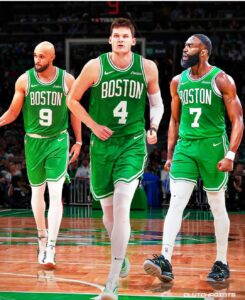The Boston Celtics, facing a daunting financial crunch and the absence of star Jayson Tatum for the 2025-26 season, have made a savvy move to secure their future while dodging the NBA’s punishing luxury tax penalties. In a three-team trade with the Utah Jazz and Miami Heat, the Celtics have acquired 24-year-old center Walker Kessler, a rim-protecting big man with untapped potential, while shedding salary and gaining flexibility.
The deal sees Boston send guard Anfernee Simons and center Neemias Queta, along with draft picks and cash considerations, to Utah. In return, the Celtics land Kessler and generate a massive $27.7 million trade exception, a tool that could prove invaluable for future roster tweaks. The trade also helps Boston slash nearly $100 million in projected payroll and tax penalties, a critical step toward ducking the luxury tax line for two consecutive seasons to reset the NBA’s harsh repeater tax penalties.
Kessler, the 22nd overall pick in the 2022 NBA Draft, brings exactly what Boston needs to fill the void at center following the departure of veterans like Kristaps Porziņģis and Jrue Holiday earlier this offseason. Standing at 7’1” with a 7’4” wingspan, Kessler is a defensive anchor, averaging 2.4 blocks per game in his first two seasons with the Jazz. His ability to protect the rim, rebound, and finish efficiently around the basket makes him a perfect fit for a Celtics team looking to retool without sacrificing competitiveness.
“This is a home run for Boston,” said an NBA executive familiar with the deal. “Kessler’s young, cheap, and fits their timeline. Plus, they’ve created cap flexibility and a trade exception that keeps them in the driver’s seat for future moves.”
Financially, the move is a masterstroke. With Tatum sidelined and the Celtics staring at a payroll and tax bill approaching half a billion dollars, shedding high-salary veterans and bringing in Kessler’s modest $2.9 million cap hit for 2025-26 allows Boston to stay competitive while avoiding the NBA’s tax apron restrictions. Kessler is also extension-eligible this offseason, but the Celtics can afford to wait until next summer when he becomes a restricted free agent, giving them time to evaluate his fit alongside stars like Jaylen Brown and Derrick White.
On the court, Kessler’s arrival addresses Boston’s need for a true center. Last season, he averaged 8.1 points, 7.5 rebounds, and 2.4 blocks in just 23.3 minutes per game for Utah, showcasing his ability to anchor a defense. His 71.3% field goal percentage highlights his efficiency as a lob threat and rim-runner, traits that should mesh seamlessly with Boston’s playmaking core. With Tatum expected to return healthy next season, Kessler could form the backbone of a revamped frontcourt, giving the Celtics a blend of youth, size, and defensive prowess.
The trade also signals a broader strategy shift for Boston. After years of heavy spending and title contention, the Celtics are embracing a soft reset. By moving on from high-cost veterans and acquiring young talent like Kessler, Boston is positioning itself to remain a championship contender while navigating the NBA’s new financial realities under the latest collective bargaining agreement.
“Boston’s not rebuilding—they’re reloading,” said an Eastern Conference scout. “Kessler gives them a long-term piece at center, and that trade exception is a weapon they can use to add another star or key role player down the line.”
For now, Celtics fans can breathe a sigh of relief. With Kessler in the fold, a healthy core of Brown, White, and eventually Tatum, and newfound financial flexibility, Boston’s front office has pulled off a quiet but seismic win this summer. The road to another championship may have just gotten a little clearer.
